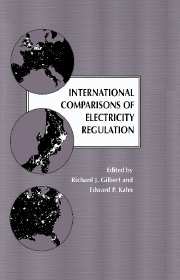Book contents
- Frontmatter
- Contents
- Preface
- International Comparisons of Electricity Regulation
- 1 Introduction: International comparisons of electricity regulation
- 2 Regulation, public ownership and privatisation of the English electricity industry
- 3 How should it be done? Electricity regulation in Argentina, Brazil, Uruguay, and Chile
- 4 From club-regulation to market competition in the Scandinavian electricity supply industry
- 5 Competition and institutional change in U.S. electric power regulation
- 6 The Japanese electric utility industry
- 7 Regulation of the market for electricity in the Federal Republic of Germany
- 8 The evolution of New Zealand's electricity supply structure
- 9 Regulation of electric power in Canada
- 10 The French electricity industry
- 11 The Yugoslav electric power industry
- Index
5 - Competition and institutional change in U.S. electric power regulation
Published online by Cambridge University Press: 21 March 2010
- Frontmatter
- Contents
- Preface
- International Comparisons of Electricity Regulation
- 1 Introduction: International comparisons of electricity regulation
- 2 Regulation, public ownership and privatisation of the English electricity industry
- 3 How should it be done? Electricity regulation in Argentina, Brazil, Uruguay, and Chile
- 4 From club-regulation to market competition in the Scandinavian electricity supply industry
- 5 Competition and institutional change in U.S. electric power regulation
- 6 The Japanese electric utility industry
- 7 Regulation of the market for electricity in the Federal Republic of Germany
- 8 The evolution of New Zealand's electricity supply structure
- 9 Regulation of electric power in Canada
- 10 The French electricity industry
- 11 The Yugoslav electric power industry
- Index
Summary
Part I. Historical background and evolution of the U.S. electric power sector
Brief history of the origins of the system
The U.S. electricity system has been, and continues to be, a patchwork of state and federal regulations in a system with private, municipal, and other government ownership. In this section we give a brief survey of the origin and early history of the activities of the public and private sectors.
Private sector activities
The nineteenth-century origins of the U.S. electricity system involved substantial technological rivalry between incompatible systems (Hughes, 1983). The technical configuration first promoted by Edison and his associates and used in the famous Pearl Street Station (1882) was based on direct current (dc). Westinghouse and others, starting later and with less financial backing, promoted alternating current (ac) primarily to achieve longer transmission and distribution distances. The technical advantage of ac was due to the comparative ease of transforming voltage to levels high enough that resistance losses from transmission were small. The dc technology was not able to achieve high-voltage transformation for decades. Therefore, in the early development of the electricity industry, each technology had natural market niches. The dc systems prevailed in dense urban areas, where they supplied lighting and power for electric railways (traction); the ac systems dominated smaller cities and towns, where their advantage in transmission over longer distances was clear.
By the early 1890s, an interface technology, the rotary converter, made it possible to blend the two technologies into a single coherent system. Eventually ac systems dominated because of their advantage in transmission.
- Type
- Chapter
- Information
- International Comparisons of Electricity Regulation , pp. 179 - 230Publisher: Cambridge University PressPrint publication year: 1996
- 9
- Cited by

